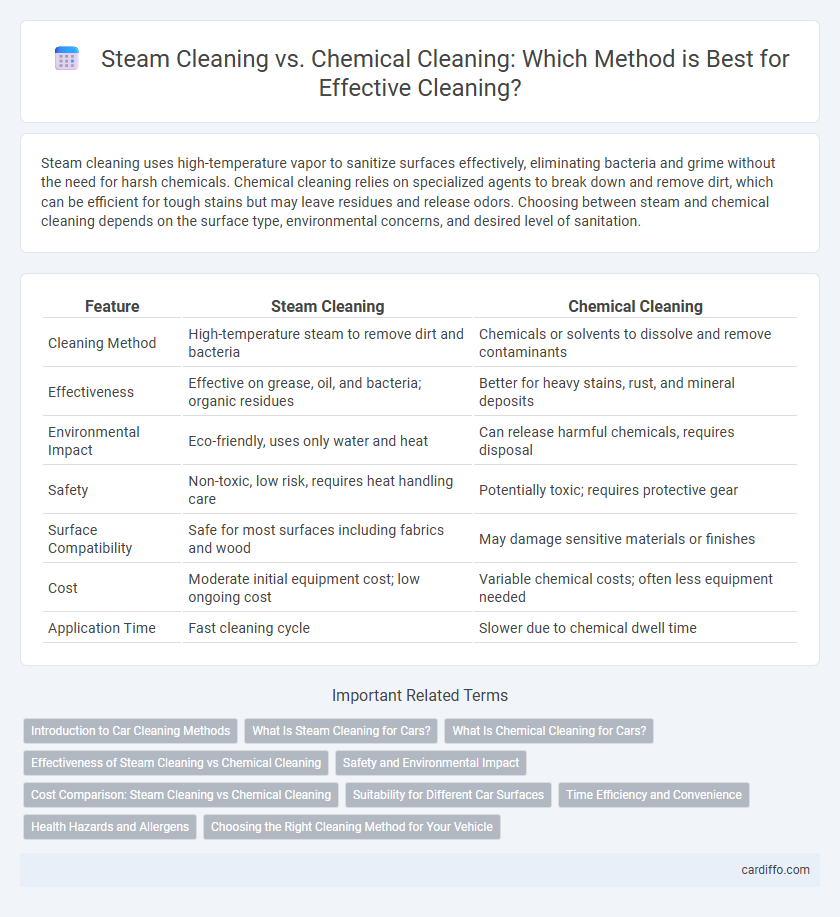Steam cleaning uses high-temperature vapor to sanitize surfaces effectively, eliminating bacteria and grime without the need for harsh chemicals. Chemical cleaning relies on specialized agents to break down and remove dirt, which can be efficient for tough stains but may leave residues and release odors. Choosing between steam and chemical cleaning depends on the surface type, environmental concerns, and desired level of sanitation.
Table of Comparison
| Feature | Steam Cleaning | Chemical Cleaning |
|---|---|---|
| Cleaning Method | High-temperature steam to remove dirt and bacteria | Chemicals or solvents to dissolve and remove contaminants |
| Effectiveness | Effective on grease, oil, and bacteria; organic residues | Better for heavy stains, rust, and mineral deposits |
| Environmental Impact | Eco-friendly, uses only water and heat | Can release harmful chemicals, requires disposal |
| Safety | Non-toxic, low risk, requires heat handling care | Potentially toxic; requires protective gear |
| Surface Compatibility | Safe for most surfaces including fabrics and wood | May damage sensitive materials or finishes |
| Cost | Moderate initial equipment cost; low ongoing cost | Variable chemical costs; often less equipment needed |
| Application Time | Fast cleaning cycle | Slower due to chemical dwell time |
Introduction to Car Cleaning Methods
Steam cleaning uses high-temperature steam to penetrate and lift dirt, grease, and grime from car surfaces without harsh chemicals, making it eco-friendly and safe for sensitive materials. Chemical cleaning relies on specialized detergents and solvents to break down stubborn stains and contaminants but may pose risks to paint, upholstery, and the environment. Both methods offer effective solutions, with steam cleaning preferred for its gentle yet thorough cleaning capabilities in modern car care.
What Is Steam Cleaning for Cars?
Steam cleaning for cars uses high-temperature steam to remove dirt, grease, and stains from vehicle surfaces without harsh chemicals. This eco-friendly method sanitizes upholstery and hard-to-reach areas by penetrating grime effectively while reducing water usage compared to traditional washing. Steam cleaning also helps eliminate bacteria and allergens, promoting a healthier car interior environment.
What Is Chemical Cleaning for Cars?
Chemical cleaning for cars involves using specialized solvents and detergents to dissolve and remove grease, dirt, and contaminants from vehicle surfaces and engine components. This method targets stubborn stains and buildup by breaking down oils and grime at a molecular level, ensuring a thorough cleanse. Chemical cleaning is often preferred for areas where steam cannot penetrate or could cause damage, providing a precise and effective solution.
Effectiveness of Steam Cleaning vs Chemical Cleaning
Steam cleaning effectively eliminates dirt, grease, and bacteria by using high-temperature vapor, making it highly efficient for sanitizing surfaces without leaving chemical residues. Chemical cleaning relies on detergents and solvents to break down contaminants, but may leave behind harmful residues and requires careful handling to avoid surface damage. Studies show steam cleaning offers superior deep cleaning and eco-friendly advantages, especially in health-sensitive environments where chemical exposure is a concern.
Safety and Environmental Impact
Steam cleaning uses high-temperature vapor to sanitize surfaces without harmful chemicals, significantly reducing toxic residues and risks to human health compared to chemical cleaning methods. Chemical cleaning often involves harsh substances that can cause respiratory issues, skin irritation, and environmental pollution through hazardous wastewater. Steam cleaning stands out as a safer, eco-friendly alternative by minimizing chemical use and ecological footprint while maintaining effective sanitation.
Cost Comparison: Steam Cleaning vs Chemical Cleaning
Steam cleaning typically incurs higher initial equipment costs but offers lower ongoing expenses due to reduced chemical purchases and waste disposal fees. Chemical cleaning involves lower upfront investment but results in recurring costs for purchasing cleaning agents and managing hazardous waste. Evaluating total cost of ownership reveals steam cleaning as more economical over time, especially in large-scale or frequent cleaning applications.
Suitability for Different Car Surfaces
Steam cleaning offers a gentle yet effective method ideal for delicate car surfaces such as leather and fabric upholstery because it uses high-temperature vapor to lift dirt without abrasive chemicals. Chemical cleaning suits stubborn stains on hard surfaces like metal and plastic trims by utilizing specialized solvents that break down grime and grease more efficiently. Selecting the appropriate cleaning technique depends on the car surface material, ensuring optimal cleaning results while preserving surface integrity.
Time Efficiency and Convenience
Steam cleaning offers superior time efficiency by rapidly loosening dirt and grime without the need for drying time, making it ideal for quick turnarounds. Chemical cleaning requires longer application and ventilation times to ensure safety and effectiveness, reducing overall convenience. Steam cleaning also eliminates the need for handling harsh chemicals, providing a safer and more user-friendly cleaning experience.
Health Hazards and Allergens
Steam cleaning eliminates harmful chemicals, reducing the risk of respiratory issues and skin irritation associated with chemical residues. Chemical cleaning often involves allergens and volatile organic compounds (VOCs) that can trigger asthma, allergies, and other health problems. Steam cleaning offers a safer alternative by using high-temperature vapor to sanitize surfaces without introducing toxic substances.
Choosing the Right Cleaning Method for Your Vehicle
Steam cleaning offers a chemical-free, eco-friendly solution that effectively removes dirt and grime while sanitizing surfaces through high-temperature vapor. Chemical cleaning can target stubborn stains and provide deep cleaning with specialized agents but may pose risks to paint and interior materials if not applied correctly. Selecting the right method depends on your vehicle's condition, sensitivity of surfaces, and environmental considerations to ensure optimal cleanliness without damage.
Steam Cleaning vs Chemical Cleaning Infographic

 cardiffo.com
cardiffo.com